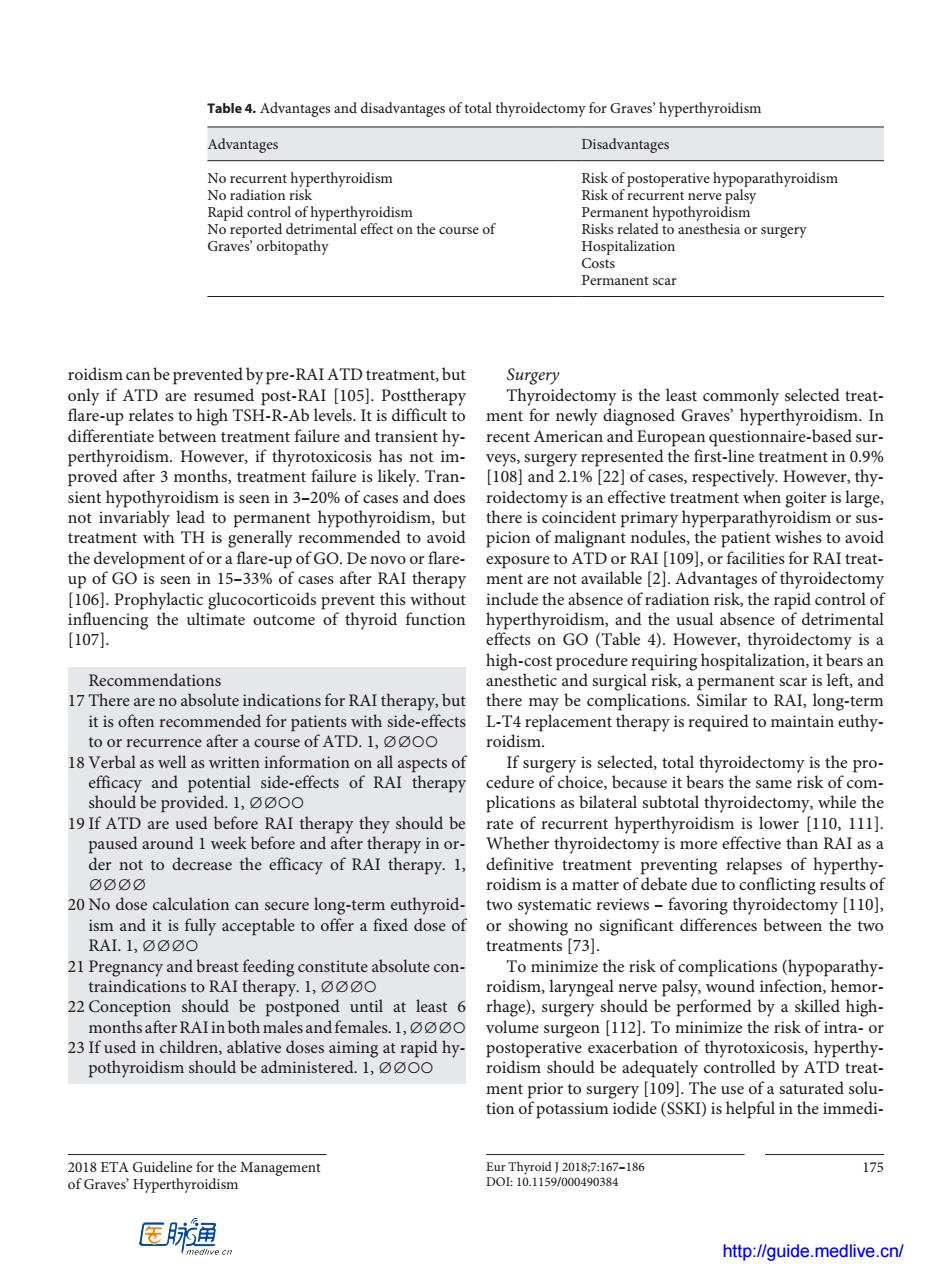正在加载图片...

Table4.Advantages and disadvantages of total thyroidectomy for Graves'hyperthyroidism Advantages Disadvantages t on the course of r surgery Graves'orbitopathy Hospitalization Permanent scar roidism can be prevented by pre-RAIATD treatment,but Surgery Thyroidectomy is the least commonly selected treat- Ab levels. een tre ean que tonnaire-bas nth、e ent ir ient hyp en in 3-20%6 of cases and doe s an effective t when goiter is lar not invariably lead to permanent hypothyroidism,but there is coincident primary hyp rparathyroidism or sus treatment with TH is generally recommended to avoid picion of malignant nodules,the patient wishes to avoid the development of or a flare-up of GO.De novo or flare- exposure to ATD or RAI[109],or facilities for RAI treat- up of GO is seen in 15-33%of cases after RAI therapy ment are not available [2].Advantages of thyroidectomy 6].Prophylacti nclud e the absence of radiation risk,the rapid control mate outcome of thyroi erthyro DS ce ts on O 4).H recommendations nent sca 17There are no absolute indications for RAI therapy,but there may be complications similar to ral long-term it is often recommended for patients with side-effects L-T4 replacement therapy is required to maintain euthy- to or recurrence after a course of ATD.1, roidism. 18 Verbal as well as written information on all aspects of If surgery is selected,total thyroidectomy is the pro side-effects of RAI therapy cedure of cho eral st are used apy they should be hyperthyro rapy f h oidism is a matter of debat e due to conflicting 20 No dose calculation can secure long-term euthyroid- two systematic reviews-favoring thyroidectomy [110]. ism and it is fully acceptable to offer a fixed dose of or showing no significant differences between the two RAL.1,O☑C reatments[73]. astfeedingconstituteabsolutecon- therapy.I, sm,larynge e palsy woun n both postpone t ge).surgery s illed by les ablativ id h Surgeon (112 n of thy pothyroidism should be administered.1, roidism should be adequately controlled by ATD treat- ment prior to surgery [109].The use of a saturated solu- tion of potassium iodide(SSKI)is helpful in the immedi- 2018 ETA Guideline for the Management 175 of GravesHyperthyroidism 医肺通 http://quide medlive.cn/2018 ETA Guideline for the Management of Graves’ Hyperthyroidism Eur Thyroid J 2018;7:167–186 175 DOI: 10.1159/000490384 roidism can be prevented by pre-RAI ATD treatment, but only if ATD are resumed post-RAI [105]. Posttherapy flare-up relates to high TSH-R-Ab levels. It is difficult to differentiate between treatment failure and transient hyperthyroidism. However, if thyrotoxicosis has not improved after 3 months, treatment failure is likely. Transient hypothyroidism is seen in 3–20% of cases and does not invariably lead to permanent hypothyroidism, but treatment with TH is generally recommended to avoid the development of or a flare-up of GO. De novo or flareup of GO is seen in 15–33% of cases after RAI therapy [106]. Prophylactic glucocorticoids prevent this without influencing the ultimate outcome of thyroid function [107]. Recommendations 17 There are no absolute indications for RAI therapy, but it is often recommended for patients with side-effects to or recurrence after a course of ATD. 1, ∅∅○○ 18 Verbal as well as written information on all aspects of efficacy and potential side-effects of RAI therapy should be provided. 1, ∅∅○○ 19 If ATD are used before RAI therapy they should be paused around 1 week before and after therapy in order not to decrease the efficacy of RAI therapy. 1, ∅∅∅∅ 20 No dose calculation can secure long-term euthyroidism and it is fully acceptable to offer a fixed dose of RAI. 1, ∅∅∅○ 21 Pregnancy and breast feeding constitute absolute contraindications to RAI therapy. 1, ∅∅∅○ 22 Conception should be postponed until at least 6 months after RAI in both males and females. 1, ∅∅∅○ 23 If used in children, ablative doses aiming at rapid hypothyroidism should be administered. 1, ∅∅○○ Surgery Thyroidectomy is the least commonly selected treatment for newly diagnosed Graves’ hyperthyroidism. In recent American and European questionnaire-based surveys, surgery represented the first-line treatment in 0.9% [108] and 2.1% [22] of cases, respectively. However, thyroidectomy is an effective treatment when goiter is large, there is coincident primary hyperparathyroidism or suspicion of malignant nodules, the patient wishes to avoid exposure to ATD or RAI [109], or facilities for RAI treatment are not available [2]. Advantages of thyroidectomy include the absence of radiation risk, the rapid control of hyperthyroidism, and the usual absence of detrimental effects on GO (Table 4). However, thyroidectomy is a high-cost procedure requiring hospitalization, it bears an anesthetic and surgical risk, a permanent scar is left, and there may be complications. Similar to RAI, long-term L-T4 replacement therapy is required to maintain euthyroidism. If surgery is selected, total thyroidectomy is the procedure of choice, because it bears the same risk of complications as bilateral subtotal thyroidectomy, while the rate of recurrent hyperthyroidism is lower [110, 111]. Whether thyroidectomy is more effective than RAI as a definitive treatment preventing relapses of hyperthyroidism is a matter of debate due to conflicting results of two systematic reviews – favoring thyroidectomy [110], or showing no significant differences between the two treatments [73]. To minimize the risk of complications (hypoparathyroidism, laryngeal nerve palsy, wound infection, hemorrhage), surgery should be performed by a skilled highvolume surgeon [112]. To minimize the risk of intra- or postoperative exacerbation of thyrotoxicosis, hyperthyroidism should be adequately controlled by ATD treatment prior to surgery [109]. The use of a saturated solution of potassium iodide (SSKI) is helpful in the immediTable 4. Advantages and disadvantages of total thyroidectomy for Graves’ hyperthyroidism Advantages Disadvantages No recurrent hyperthyroidism Risk of postoperative hypoparathyroidism No radiation risk Risk of recurrent nerve palsy Rapid control of hyperthyroidism Permanent hypothyroidism No reported detrimental effect on the course of Graves’ orbitopathy Risks related to anesthesia or surgery Hospitalization Costs Permanent scar http://guide.medlive.cn/